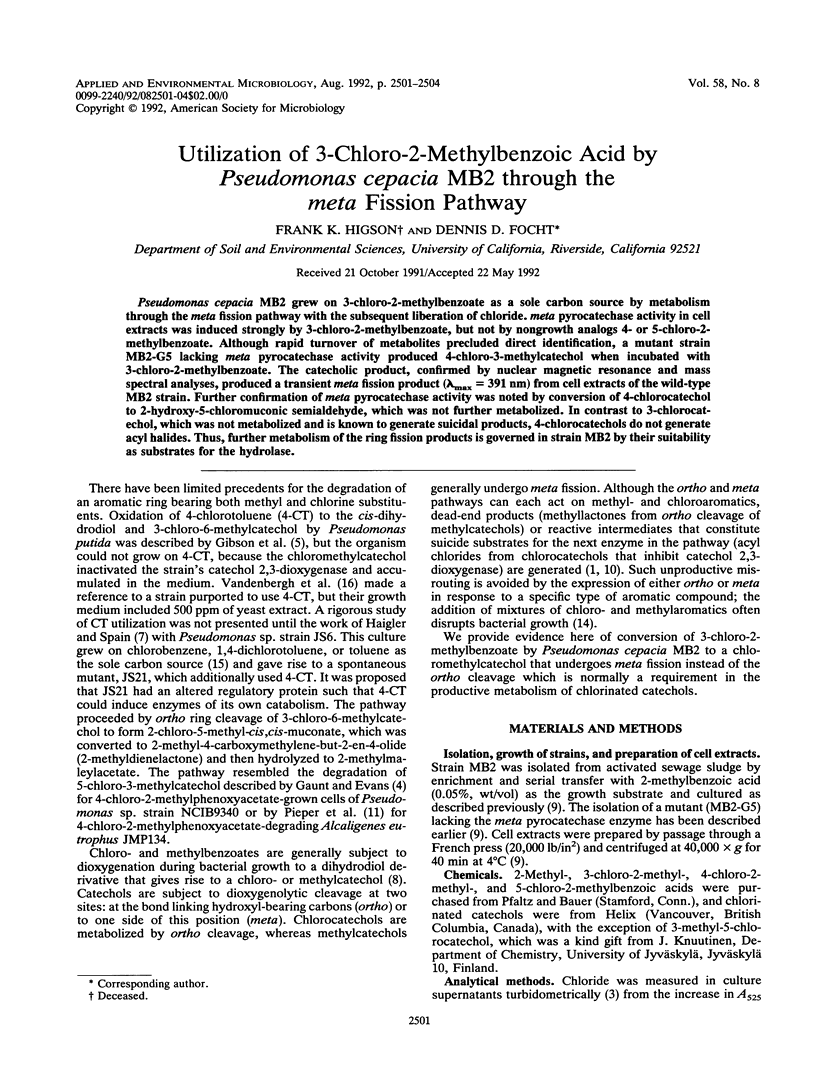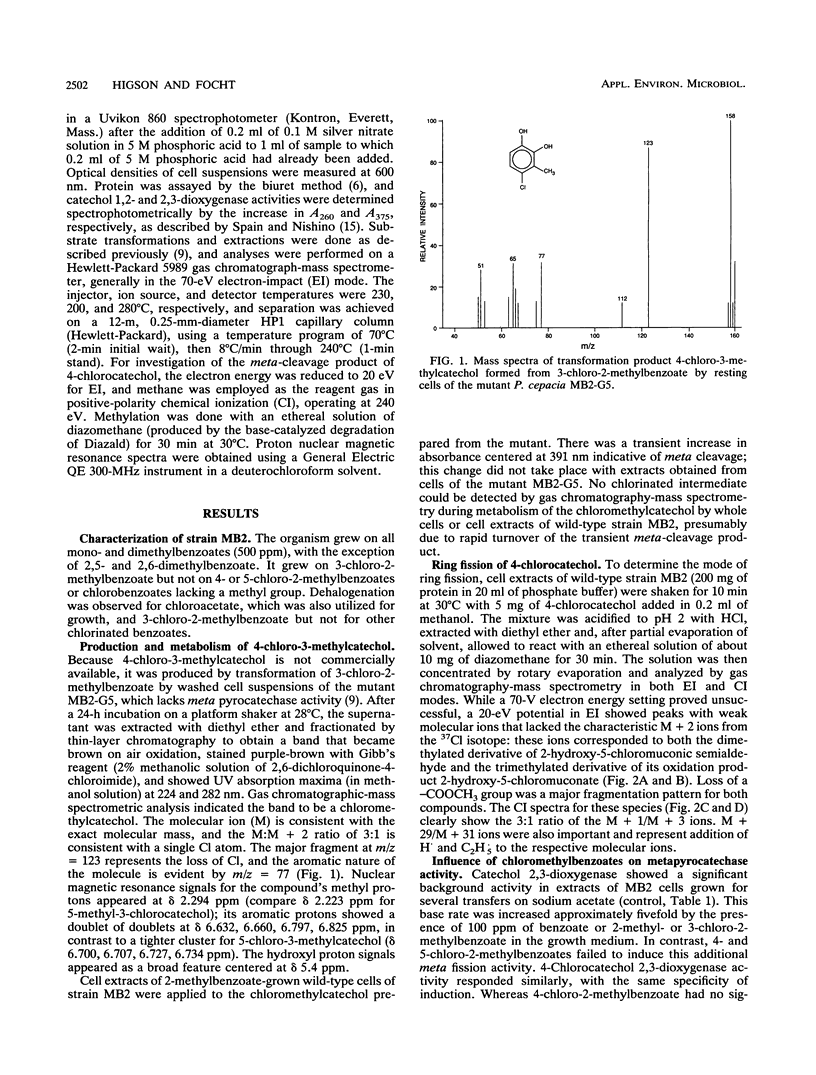Abstract
Pseudomonas cepacia MB2 grew on 3-chloro-2-methylbenzoate as a sole carbon source by metabolism through the meta fission pathway with the subsequent liberation of chloride. meta pyrocatechase activity in cell extracts was induced strongly by 3-chloro-2-methylbenzoate, but not by nongrowth analogs 4- or 5-chloro-2-methylbenzoate. Although rapid turnover of metabolites precluded direct identification, a mutant strain MB2-G5 lacking meta pyrocatechase activity produced 4-chloro-3-methylcatechol when incubated with 3-chloro-2-methylbenzoate. The catecholic product, confirmed by nuclear magnetic resonance and mass spectral analyses, produced a transient meta fission product (lambda max = 391 nm) from cell extracts of the wild-type MB2 strain. Further confirmation of meta pyrocatechase activity was noted by conversion of 4-chlorocatechol to 2-hydroxy-5-chloromuconic semialdehyde, which was not further metabolized. In contrast to 3-chlorocatechol, which was not metabolized and is known to generate suicidal products, 4-chlorocatechols do not generate acyl halides. Thus, further metabolism of the ring fission products is governed in strain MB2 by their suitability as substrates for the hydrolase.
Full text
PDF



Selected References
These references are in PubMed. This may not be the complete list of references from this article.
- Bartels I., Knackmuss H. J., Reineke W. Suicide Inactivation of Catechol 2,3-Dioxygenase from Pseudomonas putida mt-2 by 3-Halocatechols. Appl Environ Microbiol. 1984 Mar;47(3):500–505. doi: 10.1128/aem.47.3.500-505.1984. [DOI] [PMC free article] [PubMed] [Google Scholar]
- DAGLEY S., CHAPMAN P. J., GIBSON D. T., WOOD J. M. DEGRADATION OF THE BENZENE NUCLEUS BY BACTERIA. Nature. 1964 May 23;202:775–778. doi: 10.1038/202775a0. [DOI] [PubMed] [Google Scholar]
- Focht D. D., Alexander M. Aerobic cometabolism of DDT analogues by Hydrogenomonas sp. J Agric Food Chem. 1971 Jan-Feb;19(1):20–22. doi: 10.1021/jf60173a042. [DOI] [PubMed] [Google Scholar]
- Gaunt J. K., Evans W. C. Metabolism of 4-chloro-2-methylphenoxyacetate by a soil pseudomonad. Ring-fission, lactonizing and delactonizing enzymes. Biochem J. 1971 May;122(4):533–542. doi: 10.1042/bj1220533. [DOI] [PMC free article] [PubMed] [Google Scholar]
- Gibson D. T., Koch J. R., Schuld C. L., Kallio R. E. Oxidative degradation of aromatic hydrocarbons by microorganisms. II. Metabolism of halogenated aromatic hydrocarbons. Biochemistry. 1968 Nov;7(11):3795–3802. doi: 10.1021/bi00851a003. [DOI] [PubMed] [Google Scholar]
- Haigler B. E., Spain J. C. Degradation of p-chlorotoluene by a mutant of Pseudomonas sp. strain JS6. Appl Environ Microbiol. 1989 Feb;55(2):372–379. doi: 10.1128/aem.55.2.372-379.1989. [DOI] [PMC free article] [PubMed] [Google Scholar]
- Hartmann J., Reineke W., Knackmuss H. J. Metabolism of 3-chloro-, 4-chloro-, and 3,5-dichlorobenzoate by a pseudomonad. Appl Environ Microbiol. 1979 Mar;37(3):421–428. doi: 10.1128/aem.37.3.421-428.1979. [DOI] [PMC free article] [PubMed] [Google Scholar]
- Higson F. K., Focht D. D. Degradation of 2-methylbenzoic acid by Pseudomonas cepacia MB2. Appl Environ Microbiol. 1992 Jan;58(1):194–200. doi: 10.1128/aem.58.1.194-200.1992. [DOI] [PMC free article] [PubMed] [Google Scholar]
- Reineke W., Knackmuss H. J. Microbial degradation of haloaromatics. Annu Rev Microbiol. 1988;42:263–287. doi: 10.1146/annurev.mi.42.100188.001403. [DOI] [PubMed] [Google Scholar]
- Reineke W., Knackmuss H. J. Microbial metabolism of haloaromatics: isolation and properties of a chlorobenzene-degrading bacterium. Appl Environ Microbiol. 1984 Feb;47(2):395–402. doi: 10.1128/aem.47.2.395-402.1984. [DOI] [PMC free article] [PubMed] [Google Scholar]
- Spain J. C., Nishino S. F. Degradation of 1,4-dichlorobenzene by a Pseudomonas sp. Appl Environ Microbiol. 1987 May;53(5):1010–1019. doi: 10.1128/aem.53.5.1010-1019.1987. [DOI] [PMC free article] [PubMed] [Google Scholar]
- Vandenbergh P. A., Olsen R. H., Colaruotolo J. F. Isolation and genetic characterization of bacteria that degrade chloroaromatic compounds. Appl Environ Microbiol. 1981 Oct;42(4):737–739. doi: 10.1128/aem.42.4.737-739.1981. [DOI] [PMC free article] [PubMed] [Google Scholar]
- Whited G. M., McCombie W. R., Kwart L. D., Gibson D. T. Identification of cis-diols as intermediates in the oxidation of aromatic acids by a strain of Pseudomonas putida that contains a TOL plasmid. J Bacteriol. 1986 Jun;166(3):1028–1039. doi: 10.1128/jb.166.3.1028-1039.1986. [DOI] [PMC free article] [PubMed] [Google Scholar]


